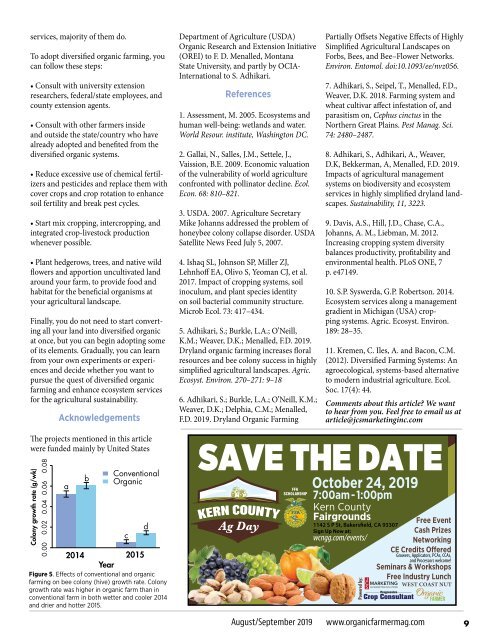Organic Farmer Aug/Sept 2019
- No tags were found...
You also want an ePaper? Increase the reach of your titles
YUMPU automatically turns print PDFs into web optimized ePapers that Google loves.
services, majority of them do.<br />
To adopt diversified organic farming, you<br />
can follow these steps:<br />
• Consult with university extension<br />
researchers, federal/state employees, and<br />
county extension agents.<br />
• Consult with other farmers inside<br />
and outside the state/country who have<br />
already adopted and benefited from the<br />
diversified organic systems.<br />
• Reduce excessive use of chemical fertilizers<br />
and pesticides and replace them with<br />
cover crops and crop rotation to enhance<br />
soil fertility and break pest cycles.<br />
• Start mix cropping, intercropping, and<br />
integrated crop-livestock production<br />
whenever possible.<br />
• Plant hedgerows, trees, and native wild<br />
flowers and apportion uncultivated land<br />
around your farm, to provide food and<br />
habitat for the beneficial organisms at<br />
your agricultural landscape.<br />
Finally, you do not need to start converting<br />
all your land into diversified organic<br />
at once, but you can begin adopting some<br />
of its elements. Gradually, you can learn<br />
from your own experiments or experiences<br />
and decide whether you want to<br />
pursue the quest of diversified organic<br />
farming and enhance ecosystem services<br />
for the agricultural sustainability.<br />
Acknowledgements<br />
Department of Agriculture (USDA)<br />
<strong>Organic</strong> Research and Extension Initiative<br />
(OREI) to F. D. Menalled, Montana<br />
State University, and partly by OCIA-<br />
International to S. Adhikari.<br />
References<br />
1. Assessment, M. 2005. Ecosystems and<br />
human well-being: wetlands and water.<br />
World Resour. institute, Washington DC.<br />
2. Gallai, N., Salles, J.M., Settele, J.,<br />
Vaission, B.E. 2009. Economic valuation<br />
of the vulnerability of world agriculture<br />
confronted with pollinator decline. Ecol.<br />
Econ. 68: 810–821.<br />
3. USDA. 2007. Agriculture Secretary<br />
Mike Johanns addressed the problem of<br />
honeybee colony collapse disorder. USDA<br />
Satellite News Feed July 5, 2007.<br />
4. Ishaq SL, Johnson SP, Miller ZJ,<br />
Lehnhoff EA, Olivo S, Yeoman CJ, et al.<br />
2017. Impact of cropping systems, soil<br />
inoculum, and plant species identity<br />
on soil bacterial community structure.<br />
Microb Ecol. 73: 417–434.<br />
5. Adhikari, S.; Burkle, L.A.; O’Neill,<br />
K.M.; Weaver, D.K.; Menalled, F.D. <strong>2019</strong>.<br />
Dryland organic farming increases floral<br />
resources and bee colony success in highly<br />
simplified agricultural landscapes. Agric.<br />
Ecosyst. Environ. 270–271: 9–18<br />
6. Adhikari, S.; Burkle, L.A.; O’Neill, K.M.;<br />
Weaver, D.K.; Delphia, C.M.; Menalled,<br />
F.D. <strong>2019</strong>. Dryland <strong>Organic</strong> Farming<br />
Partially Offsets Negative Effects of Highly<br />
Simplified Agricultural Landscapes on<br />
Forbs, Bees, and Bee–Flower Networks.<br />
Environ. Entomol. doi:10.1093/ee/nvz056.<br />
7. Adhikari, S., Seipel, T., Menalled, F.D.,<br />
Weaver, D.K. 2018. Farming system and<br />
wheat cultivar affect infestation of, and<br />
parasitism on, Cephus cinctus in the<br />
Northern Great Plains. Pest Manag. Sci.<br />
74: 2480–2487.<br />
8. Adhikari, S., Adhikari, A., Weaver,<br />
D.K, Bekkerman, A, Menalled, F.D. <strong>2019</strong>.<br />
Impacts of agricultural management<br />
systems on biodiversity and ecosystem<br />
services in highly simplified dryland landscapes.<br />
Sustainability, 11, 3223.<br />
9. Davis, A.S., Hill, J.D., Chase, C.A.,<br />
Johanns, A. M., Liebman, M. 2012.<br />
Increasing cropping system diversity<br />
balances productivity, profitability and<br />
environmental health. PLoS ONE, 7<br />
p. e47149.<br />
10. S.P. Syswerda, G.P. Robertson. 2014.<br />
Ecosystem services along a management<br />
gradient in Michigan (USA) cropping<br />
systems. Agric. Ecosyst. Environ.<br />
189: 28–35.<br />
11. Kremen, C. Iles, A. and Bacon, C.M.<br />
(2012). Diversified Farming Systems: An<br />
agroecological, systems-based alternative<br />
to modern industrial agriculture. Ecol.<br />
Soc. 17(4): 44.<br />
Comments about this article? We want<br />
to hear from you. Feel free to email us at<br />
article@jcsmarketinginc.com<br />
The projects mentioned in this article<br />
were funded mainly by United States<br />
Colony growth rate (g/wk)<br />
0.08<br />
0.06<br />
0.04<br />
0.02<br />
0.00<br />
a<br />
b<br />
Conventional<br />
<strong>Organic</strong><br />
2014 2015<br />
Year<br />
Figure 5. Effects of conventional and organic<br />
farming on bee colony (hive) growth rate. Colony<br />
growth rate was higher in organic farm than in<br />
conventional farm in both wetter and cooler 2014<br />
and drier and hotter 2015.<br />
c<br />
d<br />
SAVE THE DATE<br />
<br />
<br />
October 24, <strong>2019</strong><br />
7:00am - 1:00pm<br />
Kern County<br />
Fairgrounds<br />
1142 S P St, Bakersfield, CA 93307<br />
Sign Up Now at:<br />
wcngg.com/events/<br />
Powered by:<br />
Free Event<br />
Cash Prizes<br />
Networking<br />
CE Credits Offered<br />
Growers, Applicators, PCAs, CCAs,<br />
and Processors welcome!<br />
Seminars & Workshops<br />
Free Industry Lunch<br />
<strong>Aug</strong>ust/<strong>Sept</strong>ember <strong>2019</strong><br />
www.organicfarmermag.com<br />
9


















